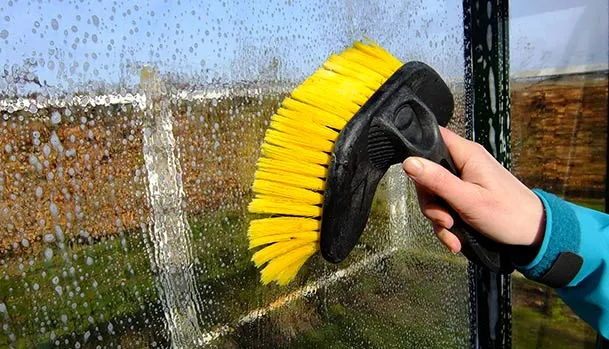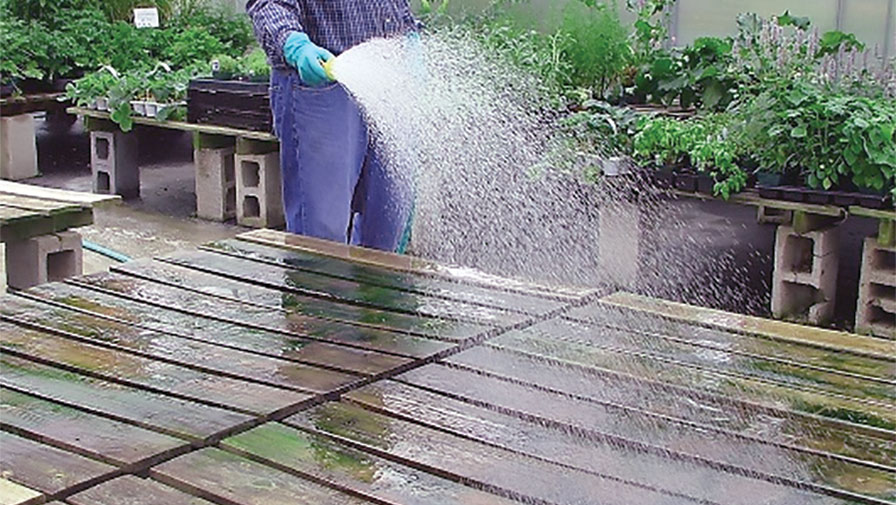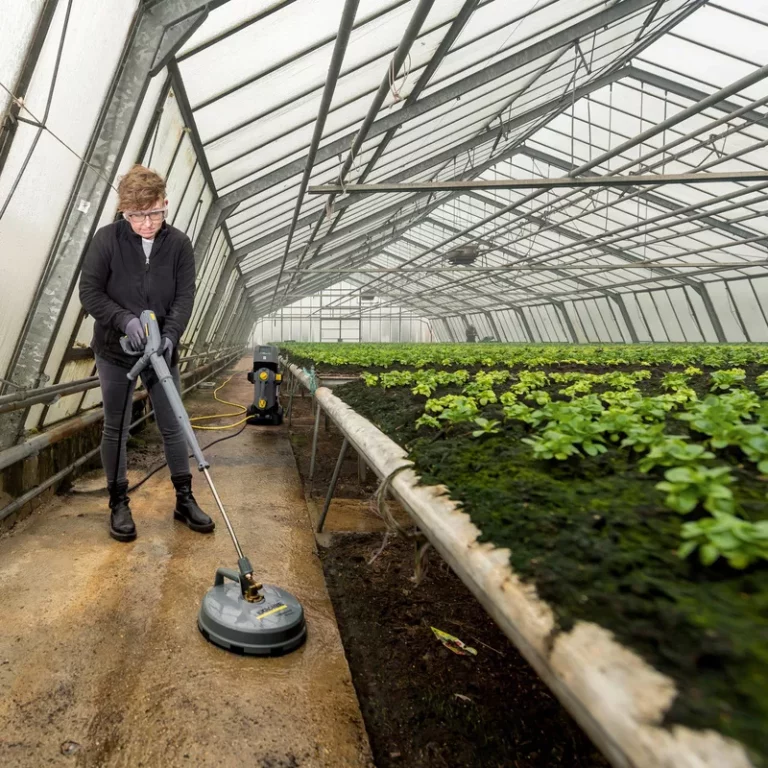As I walked into my greenhouse, filled with lots of healthy plants, I noticed how beautiful it looked. The air smelled like fresh dirt, and sunlight was shining through the windows, making everything inside look bright and happy. It made me realize how important it is to keep the greenhouse clean for my plants.
Let’s talk about taking care of your greenhouse. It’s not just about what you plant; it’s also about how you keep things clean and healthy. I’ll show you how to do it, so your plants can grow really well.
To keep your greenhouse clean following these quick methods :
- Remove debris and dead plant material regularly.
- Clean and sanitize tools and pots.
- Control weeds.
- Maintain good air circulation with proper ventilation.
- Check for pests and diseases regularly.
- Clean benches and surfaces, and sanitize periodically.
- Maintain a clean watering system.
- Keep greenhouse glazing clean for maximum light.
- Organize and declutter regularly.
- Practice good personal hygiene.
- Consider using beneficial insects.
- Quarantine new plants before introducing them.
What supplies are needed for greenhouse cleaning?

To ensure effective greenhouse cleaning, gather these essential supplies:
Gathering Necessary Supplies and Equipment:
When preparing for greenhouse cleaning, it’s essential to gather the right supplies. This includes items like brushes, brooms, rags, disinfectants, and cleaning agents.
Consider having separate tools for different areas of the greenhouse, especially if you’re growing different types of plants. This helps prevent the spread of pests and diseases.
Additionally, you might need personal protective equipment (PPE) such as gloves, masks, and goggles to ensure your safety during the cleaning process.
Safety Precautions:
Safety should be a top priority when cleaning your greenhouse. Before starting, ensure good ventilation by opening doors and windows to let fresh air circulate.
Moreover, be cautious when using cleaning agents and chemicals. Always follow the manufacturer’s instructions and wear appropriate protective gear.
Check for any electrical hazards, such as exposed wires or damaged outlets, and address them before cleaning.
Creating a Cleaning Schedule:
Establishing a cleaning schedule is crucial to maintaining a clean and healthy greenhouse. It helps you stay organized and ensures that cleaning tasks are consistently performed.
Consider factors like the time of year, plant growth cycles, and your own availability when
creating the schedule.
Divide cleaning tasks into daily, weekly, monthly, and seasonal categories to ensure that all aspects of the greenhouse are properly maintained.
How to clean greenhouse surfaces effectively?
Maintaining a pristine greenhouse environment begins with mastering the art of cleaning its surfaces with precision and care.
Removing Debris and Clutter:
Regularly removing debris like fallen leaves, dead plants, and other clutter is vital. This prevents the buildup of organic matter that can harbor pests and diseases. Clean gutters and downspouts to ensure proper drainage and prevent water-related issues like mold and mildew.
Check for and remove any signs of rodent or insect infestations during this process.
Cleaning and Sanitizing Greenhouse Surfaces:
Clean greenhouse surfaces thoroughly to remove dust, dirt, and algae, which can hinder light penetration and plant growth.
Moreover, use appropriate cleaning agents that are safe for plants and follow guidelines for dilution and application.
Regularly sanitize surfaces to prevent the spread of pathogens. This is especially crucial if you’re reusing pots, trays, or other equipment.
Checking for and Repairing Structural Issues:
Regular inspections are necessary to identify structural issues like leaks, broken glass, or damaged framework. Address these issues promptly to maintain a controlled and optimal growing environment.
Neglecting structural repairs can lead to energy inefficiency and costly problems in the long run.
Cleaning and Inspecting Ventilation Systems:
Proper ventilation is critical for regulating temperature and humidity levels in a greenhouse.
Clean and inspect fans, vents, and louvers regularly to ensure they are working correctly.
Moreover, lubricate moving parts and replace worn-out components as needed to maintain efficient ventilation.
What is the best way to sanitize garden tools?
Ensuring the longevity and hygiene of your gardening tools hinges on employing the most effective sanitization methods.
Cleaning and Disinfecting Pots, Trays, and Tools:
Properly cleaning and disinfecting pots, trays, and gardening tools is essential to prevent the spread of diseases and pests. Start by removing any organic matter or soil residues from containers and tools. This can be done using a brush or hose.
To disinfect, soak containers and tools in a solution of water and a mild bleach solution (1 part bleach to 9 parts water) or another disinfectant recommended for gardening.
Rinse thoroughly and allow them to air dry before reuse.
Sanitizing Irrigation Systems:
Irrigation systems, including hoses, pipes, and drip lines, should be regularly sanitized to prevent clogs and the buildup of pathogens. Flush the irrigation system with clean water to remove any debris.
Furthermore, periodically use a hydrogen peroxide solution (follow manufacturer’s instructions) to sanitize the irrigation lines and prevent the growth of harmful microorganisms.
Moreover, ensure that nozzles and emitters are clean and free from blockages to maintain even water distribution.
Managing Soil and Substrate Cleanliness:
Soil and substrate cleanliness is crucial to prevent soil-borne diseases and maintain plant health. Consider using pasteurized or sterilized soil mixes to reduce the risk of introducing pathogens.
Furthermore, avoid using soil from your garden in the greenhouse, as it may contain pests or diseases.
Implement a strict “no-shoes” policy inside the greenhouse to prevent the introduction of soil and contaminants.
How to prevent common greenhouse pests?

Safeguarding your greenhouse against common pests is a proactive strategy that demands vigilance and a multifaceted approach.
Implementing Preventative Measures:
- Prevention is key to managing pests and diseases in a greenhouse.
- Use physical barriers like screens on doors and windows to keep out insects and pests.
- Practice good plant hygiene by removing dead or infected plant material promptly.
- Quarantine new plants for a period before introducing them to the greenhouse to check for signs of pests or diseases.
Identifying and Addressing Common Greenhouse Pests:
- Familiarize yourself with common greenhouse pests such as aphids, whiteflies, and spider mites.
- Regularly inspect plants for signs of infestations, such as yellowing leaves or small webs.
- Implement appropriate pest control measures, which may include biological controls (predatory insects), organic pesticides, or neem oil.
- Monitor pest populations to determine the effectiveness of your control methods.
Dealing with Plant Diseases and Fungal Issues:
- Plant diseases and fungal issues can quickly spread in a greenhouse.
- Proper spacing between plants to improve air circulation can help prevent fungal problems.
- Remove and dispose of infected plant material away from the greenhouse to prevent the spread of disease.
- Apply fungicides or fungicides as a preventive measure or to control existing fungal issues, following recommended application rates and timing.
What’s the key to optimal greenhouse humidity?
The key to achieving optimal greenhouse humidity lies in a delicate balance of control and natural regulation.
Monitoring and Managing Humidity and Temperature:
Maintaining optimal humidity and temperature levels is essential for plant health and disease prevention in a greenhouse. Use hygrometers and thermometers to monitor humidity and temperature regularly.
Furthermore, implement proper ventilation, shading, and heating systems to control these factors. Adjust these settings based on the specific needs of the plants you are growing and the outside climate conditions.
Proper Disposal of Waste and Plant Debris:
Disposing of waste and plant debris in a responsible manner is crucial to maintain cleanliness and prevent disease. Consider composting plant material if it’s free of diseases.
Hence, this can provide valuable organic matter for future use. Dispose of diseased plant material away from the greenhouse to prevent the spread of pathogens. Moreover, use designated containers for waste collection and establish a regular disposal routine.
Organizing and Optimizing Greenhouse Layout:
A well-organized greenhouse layout can improve cleanliness and efficiency. Group plants with similar requirements together to simplify care and maintenance.
Create clear pathways for easy access and inspection of plants. Utilize shelving, hanging systems, and storage solutions to maximize space and keep the greenhouse clutter-free.
How to use eco-friendly products for greenhouse cleaning?
Embracing eco-friendly products for greenhouse cleaning is a sustainable choice that requires a shift in approach and mindset.
Using Eco-Friendly Cleaning Products:
Choose cleaning products that are biodegradable and environmentally friendly. Look for organic and non-toxic options that won’t harm plants, beneficial insects, or the ecosystem.
Moreover, read product labels carefully to ensure they meet your sustainability criteria.
Water Conservation Strategies:
Greenhouses can be water-intensive, so implementing water conservation measures is essential. Install rainwater harvesting systems to collect and reuse rainwater for irrigation.
In addition, use drip irrigation or soaker hoses to minimize water wastage. Implement water-efficient practices, such as mulching, to reduce evaporation from the soil.
Integrated Pest Management Techniques:
- Integrated Pest Management (IPM) involves a holistic approach to pest control.
- Utilize natural predators like ladybugs or parasitic wasps to control pest populations.
- Implement trap crops or sticky traps to monitor and reduce pest numbers.
- Consider biological control agents and biopesticides as alternatives to chemical treatments.
FAQ’s
How do I clean my greenhouse and how often?
Clean your greenhouse by removing debris, washing surfaces with soapy water, and disinfecting with a diluted bleach solution. Frequency depends on factors like climate and usage but typically seasonally or annually.
How do you maintain a greenhouse?
Maintain your greenhouse by monitoring temperature and humidity, inspecting for pests, regularly watering plants, and cleaning to prevent mold and disease.
How do you sanitize a greenhouse?
Sanitize your greenhouse by cleaning surfaces with a 10% bleach solution or using commercial greenhouse disinfectants. Ensure proper ventilation during and after sanitization.
How do I stop my greenhouse from rusting?
Prevent greenhouse rust by using rust-resistant materials like aluminum or galvanized steel. Apply rust-resistant coatings and keep the greenhouse dry to minimize moisture exposure.
Why is it important to keep a greenhouse clean?
Keeping a greenhouse clean is vital to prevent disease, mold, and pest infestations, ensuring a healthy environment for plant growth and maximizing crop yield.
Do greenhouses need sun?
Yes, greenhouses require sunlight for photosynthesis and plant growth. However, they may also have shading systems to control light levels and prevent overheating. Finding the right balance is essential for plant health.
Final Words
In conclusion, as a greenhouse enthusiast, I have come to appreciate the intricate balance required to maintain a pristine and thriving growing space. From diligently preparing for cleaning by gathering the right tools and observing safety measures to the meticulous task of sanitizing equipment and managing soil cleanliness, each step plays a crucial role in fostering a healthy environment for plants.
Furthermore, pest and disease management strategies, including prevention, identification, and addressing common issues, are pivotal in safeguarding the greenhouse ecosystem.
Moreover, upholding a clean environment extends to monitoring and regulating humidity and temperature, proper waste disposal, and optimizing the greenhouse layout.
Lastly, sustainable cleaning practices not only promote environmental responsibility but also contribute to the overall health and productivity of your greenhouse.

